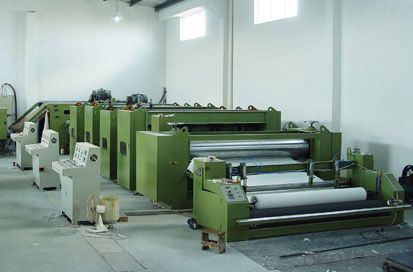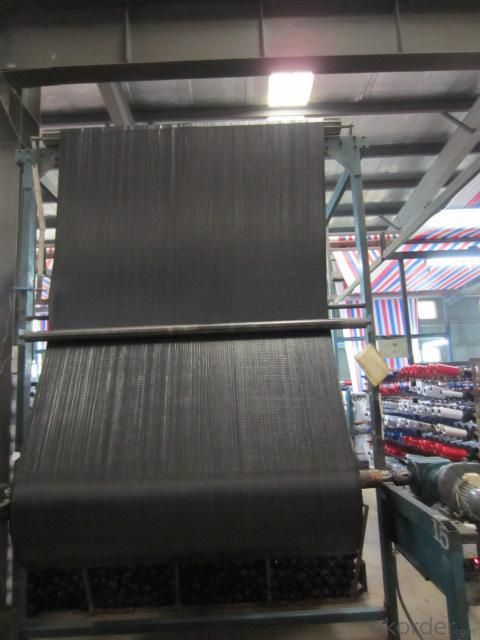Geotextile Fabric Philippines - Polypropylene (PP) Needle Punched Nonwoven Fabric for Road Construction
- Loading Port:
- Qingdao
- Payment Terms:
- TT OR LC
- Min Order Qty:
- 10000 m²
- Supply Capability:
- 500000 m²/month
OKorder Service Pledge
OKorder Financial Service
You Might Also Like
Specification
Structure of High Tensile Non Woven Polypropylene Geotextile Description:
Plastic woven film yarn geotextile is a kind of geotextile made by extruding, cuting film,stretching to film yarn (monofilament, split-film yarn) ,weaving.
Main Features of the Non Woven Polypropylene Geotextile :
The geotextile is made of polypropylene staple fibers on cross-laying equipment and needle punched equipment.
Used in dam, tunnel, reservoir, channel and roofing for anti-leakage, It laso used in scrap yard protection.
1.woven geotextile(reinforced geotextile)
2.Materials:PP
3.Tensile strength:15~100kn/m
4.Unit weight:100~400g/m2
5.Width:1 ~ 6m
Non Woven Polypropylene Geotextile Images




Non Woven Polypropylene GeotextileSpecification:
1.plastic woven geotextile for dam
2.Materials:PP
3.Tensile strength:15~100kn/m
4.Unit weight:100~400g/m2
5.Width:1 ~6m
Item | Index | ||||||
20-15 | 30-22 | 40-28 | 50-35 | 60-42 | 80-56 | 100-70 | |
Breaking strength at warp direction (kN/m) ≥ | 20 | 30 | 40 | 50 | 60 | 80 | 100 |
Breaking strength at weft direction (kN/m) ≥ | 15 | 22 | 28 | 35 | 42 | 56 | 70 |
Elongation at break (%) ≤ | 28 | ||||||
Trapezoid tearing strength( warp direction ) (kN) ≥ | 0.3 | 0.45 | 0.5 | 0.6 | 0.75 | 1.0 | 1.2 |
Bursting strength (kN) ≥ | 1.6 | 2.4 | 3.2 | 4.0 | 4.8 | 6.0 | 7.5 |
Vertical permeability coefficient (cm/s) | 10-1~10-4 | ||||||
Effective pore size O95,mm | 0.08~0.5 | ||||||
Mass per unit area (g/m2) | 120 | 160 | 200 | 240 | 280 | 340 | 400 |
Mass error in unit area (%) | ±10 | ±10 | ±10 | ±10 | ±10 | ±10 | ±10 |
FAQ
We have organized several common questions for our clients,may help you sincerely:
Q1: How about your company?
A1:Our company are one of the largest geosynthetic products supplier in the world.We have the products experience more than 20 years.Already export to USA/Germeny/Australia/Zambia/Brazil etc.more than 20 countries.Almost 10years.Our products including Geocell/Fiberglass Geogrid/Geomembrane/Geotextile/Geonet etc.
Q2.Does your products have good qualitity?
A2:Yes,we have do many big projects such as the 2008 Beijing Olympic BIRD NEST. Divert water from the south to the north project. And our products have CE certificate also.
Q3:How long can we receive the products after purchase?
A3:In the purchase of product within three working days, We will arrange the factory delivery as soon as possible. The pecific time of receiving is related to the state and position of customers.Commonly 15-20 working days can be delivery.
- Q: Can geotextiles be used in pond liner systems?
- Yes, geotextiles can be used in pond liner systems. Geotextiles are often used as an additional layer in pond liner systems to provide protection, filtration, and stability. They can help prevent punctures, control soil erosion, and improve water quality by filtering out fine particles.
- Q: Highway on the highway geotextile laying program who has ah?
- The specific construction program, ah, that depends on your specific project, but generally there is such a Hongxiang professional construction staff introduction We usually in the highway geotextile before the laying of the first sprinkle asphalt sticky oil, the amount of about 0.4 ~ 0.6kg / ㎡, and then shop geotextile, and then sprinkle a layer of geotextile in the same type of sticky oil, the amount of about 0.5 ~ 0.6kg / ㎡, also need to pay attention to the temperature when the contact. Geotextile laying before laying a layer of asphalt is to better play the role of anti-seepage, geotextile to adapt to the contact with the asphalt and other materials when the temperature, requiring a higher melting point. The asphalt impregnated geotextile into spray asphalt combined with oil, the geotextile firmly rolled in the above and then spray a thin layer of asphalt, increase the adhesion of the opposite layer, improve water resistance. If the use of paver laying asphalt concrete surface layer, can not spray surface layer of asphalt, only in the bottom to increase the amount of asphalt, control in 1000g / m2 or so. After rolling, the asphalt through its pores through the geotextile reverse osmosis to the surface layer, forming a sealed waterproof layer, but also play a role in reinforcement, improve the new layer of anti-fatigue performance. It is economical and durable.
- Q: What are the specifications for geotextiles in sediment control projects?
- The specifications for geotextiles in sediment control projects typically include factors such as the material type, weight, permeability, and strength. They should be made of durable materials that can withstand environmental conditions and retain sediment effectively. The weight of the geotextile is usually specified to ensure proper retention of sediment particles. Permeability is an important factor as it allows water to pass through while retaining sediment. Lastly, the strength of the geotextile should be sufficient to withstand installation and potential stress from soil erosion.
- Q: What are the key considerations for geotextile installation in high wind areas?
- The key considerations for geotextile installation in high wind areas include selecting a high-strength geotextile material, ensuring proper anchoring and securing methods, evaluating the site's wind load potential, and implementing effective quality control measures to ensure the installation's durability and long-term performance.
- Q: Can geotextiles be used in erosion control in stormwater detention ponds?
- Yes, geotextiles can be used in erosion control in stormwater detention ponds. Geotextiles are commonly used to stabilize and reinforce soil, prevent erosion, and filter water in various construction and environmental applications, including stormwater management. By placing geotextiles on the slopes and bottoms of stormwater detention ponds, they can help prevent soil erosion caused by the flow of stormwater, reduce sedimentation, and improve the overall effectiveness of the pond in controlling and managing stormwater runoff.
- Q: How do geotextiles help with reinforcement of geosynthetic tubes?
- Geotextiles play a crucial role in the reinforcement of geosynthetic tubes by providing added strength and stability to the structure. They act as a barrier between the tube and the surrounding soil, preventing soil particles from infiltrating the tube and causing potential damage. Geotextiles also distribute loads evenly across the tube, reducing the risk of localized stress concentrations. By enhancing the overall stability and load-bearing capacity of the tube, geotextiles significantly contribute to the reinforcement and longevity of geosynthetic tubes in various engineering applications.
- Q: What are the standards and specifications for geotextiles?
- Geotextiles are specifically engineered fabrics used in civil engineering projects to enhance soil stability, filtration, drainage, and separation. The standards and specifications for geotextiles are established by various organizations, including the International Organization for Standardization (ISO) and the American Society for Testing and Materials (ASTM). These standards outline the testing methods and performance requirements for geotextiles in terms of their physical properties, strength, durability, and resistance to environmental factors. These standards ensure that geotextiles meet the necessary quality and performance criteria for their intended applications, promoting consistency and reliability in the construction industry.
- Q: Can geotextiles be used in canal lining applications?
- Yes, geotextiles can be used in canal lining applications. Geotextiles are often utilized as a barrier or separator between different soil layers in canal lining to prevent soil erosion and provide stability. They offer excellent filtration properties and can help in the effective drainage of water from the canal. Additionally, geotextiles can also reinforce the canal lining, enhancing its durability and reducing the chances of cracks or damage.
- Q: Are geotextiles environmentally friendly?
- Yes, geotextiles are environmentally friendly. They are made from natural or synthetic fibers that are biodegradable and do not release harmful substances into the environment. Geotextiles also help to prevent soil erosion, promote vegetation growth, and improve water quality, making them a sustainable solution for various environmental applications.
- Q: What are the different geotextile durability testing standards?
- There are several different geotextile durability testing standards, including ASTM D4355, ISO 12956, and ISO 12236. These standards evaluate the durability and performance of geotextiles by subjecting them to various mechanical, chemical, and environmental tests.
Send your message to us
Geotextile Fabric Philippines - Polypropylene (PP) Needle Punched Nonwoven Fabric for Road Construction
- Loading Port:
- Qingdao
- Payment Terms:
- TT OR LC
- Min Order Qty:
- 10000 m²
- Supply Capability:
- 500000 m²/month
OKorder Service Pledge
OKorder Financial Service
Similar products
Hot products
Hot Searches
Related keywords


































